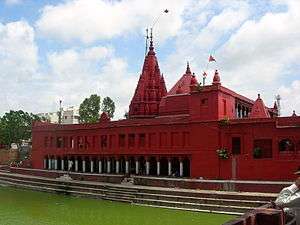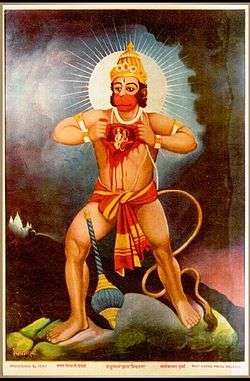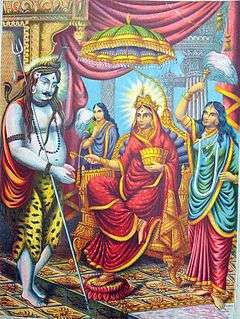Hindu temples in Varanasi
Varanasi, also known as Benares,[1] Banaras (Banāras), or Kashi (Kāśī), is the holiest of the seven sacred cities (Sapta Puri) in Hinduism and Jainism, and played an important role in the development of Buddhism. Hindus believe that death at Varanasi brings salvation.[2] It is one of the oldest continuously inhabited cities in the world. Varanasi is also known as the favourite city of the Hindu deity Lord Shiva.[3][4]
Varanasi is also famous for housing numerous temples. Several temples in Varanasi have great religious and historical importance in Hinduism. There are many temples, erected at different times throughout the history of Varanasi. Some of the popular temples are listed herein.

Aghori
- Baba Keenaram Sthal: Headquarters and location of the world famous Pilgrim of Aghora sect. Work place of great saint Baba Keenaram. One of the most visited places in Varanasi, by researchers, documentary makers, writers and tourists.
 An Aghori with a human skull, c. 1875.
An Aghori with a human skull, c. 1875.
Bharat Mata
- Bharat Mata Mandir: Bharat Mata Mandir ("Mother India Temple") is located on the Mahatma Gandhi Kashi Vidyapith campus in Varanasi, India. Instead of traditional statues of Gods and Goddesses, this temple has a huge map of undivided India carved in marble. This temple is dedicated to Mother India and claims to be the only one of its kind in the world.[5][6][7][8][9][10]
 Relief map of India in Bharat Mata Mandir
Relief map of India in Bharat Mata Mandir
Dhanvantari "Kashiraj Devodas"- The God of Medicines
In Varanaseya Sanskrit Vishwavidyalaya, Varanasi, Uttar Pradesh state, one statue of Dhanvantari is present in the University museum. One Black stoned statue facing south is situated in a personal property of a Brahman family in Chowk area, varanasi. It's said that the Idol was found beneath the premises of that property when it was getting constructed and the Brahman couldn't figure out who it was hence decided to have it drifted in Ganga next morning, however same night lord came in his dream and introduced himself as KashiRaja Devodas(Dhanvantari) and asked to remain his Idol where it was found, hence he built this temple in his house and his successors are still serving the Lord there. This temple said to be quite awakened and spiritual as the idol emerged on its own and its a local belief that if some one worships here with all his faith, Lord cures his illness.
Durga or her Avatar
- Durga Mandir: The architecture of Durga Mandir is of a Nagara Style, which is typical of North India. The temple has a rectangular tank of water called the Durga Kund ("Kund" meaning a pond or pool.) The temple has multi-tiered spires and is stained red with ochre, representing the red colour of Durga. The Kund was initially connected directly to the river thus the water was automatically replenished. This channel was later closed, locking off the water supply, which is replenished only by rain or drainage from the Temple. Every year on the occasion of Nag Panchami, the act of depicting Lord Vishnu reclining on the coiled-up mystical snake or "Shesha" is recreated in the Kund.
- Durga Mandir main gate
 18th century Durga Temple, overlooking the Durga Kund
18th century Durga Temple, overlooking the Durga Kund
- Sankata Devi Mandir: Sankata Devi Mandir is situated near the Sindhia Ghat, there is an important temple of the "Goddess of Remedy", Devi Sankatha. Inside its premises there is a huge statue of a lion. There are also nine temples of nine planets near to this temple.
Hanuman
 Hanuman painted by Pahari Painter
Hanuman painted by Pahari Painter Hanuman fetches the herb-bearing mountain, in a print from the Ravi Varma Press, 1910's
Hanuman fetches the herb-bearing mountain, in a print from the Ravi Varma Press, 1910's
- Sankat Mochan Mandir: Sankat Mochan Mandir is dedicated to Lord Hanuman. It is very popular with locals. It is the location for many yearly religious as well as cultural festivals. On 7 March 2006 one of the three explosions carried out by Islamic militants hit the temple, while the aarti, in which numerous worshippers and wedding attendees participated, was in progress.[11]
Parvati or her Avatar
- Annapurna Devi Mandir: Annapurna Devi Mandir is located near the Kashi Vishwanath temple, there is a nice temple of Devi Annapurna, believed to be the "Goddess of Food". She is a form of Parvati. She is also known as Kashipuraadeeshwari ("Queen of Kasi").
 Annapurna Devi
Annapurna Devi
- Lalita Gauri Mandir: Temple dedicated to the goddess Lalita Gauri.
- Vishalakshi Temple: Vishalakshi Temple is dedicated to Vishalakshi (means wide-eyed) or Parvati, the consort of Lord Shiva.
Shiva or his Avatar
.jpg)
- Kashi Vishwanath Temple: Kashi Vishwanath Temple is one of the most famous Hindu temples and is dedicated to Lord Shiva. This is one of the most worshiped Shiva temple in Hinduism and has been mentioned in the Puranas including the Kashi Khanda (section) of Skanda Purana. The original Vishwanath temple was destroyed by the army of Qutb-ud-din Aibak in 1194 CE, when he defeated the Raja of Kannauj as a commander of Mohammad Ghori. The temple has been destroyed and rebuilt several times in the past 800 years and the existing structure was erected in 18th century.
- Kaal Bhairav Mandir: Kaal Bhairav Mandir is an ancient temple of Varanasi near the main Post Office, VishesharGanj. Lord Kaal Bhairav is believed to be the "Kotwal of Varanasi". Without his permission no one can stay in Kashi.
- Mrityunjay Mahadev Mandir: Mrityunjay Mahadev Mandir of Lord Shiva is situated on the route from Daranagar to the Kalbhairav temple. Just beside this temple there is a well of much religious importance. Its water is said to be a mixture of several underground streams and good for eliminating several diseases.
- New Vishwanath Mandir (Birla Mandir): The New Vishwanath Mandir, also called Birla Mandir, mainly funded by Birla family, was built as a replica of the old Kashi Vishwanath Temple. Planned by Madan Mohan Malaviya, the temple is part of the Banaras Hindu University campus, and represents national revival. The temple is open to people of all castes and religions. There are nine temples in the Sri Vishwanath Temple campus, including Vishwanathji (Shiva Lingam), Natarajji, Mata Parvatiji, Ganesji, Mata Saraswatiji, Panchmukhi Mahadev, Hanumanji, and Nandiji. There are idols of Lord Shiva and Lakshmi Narayanji.
- New Vishwanath Temple side view
- Shri Tilbhandeshwar Mahadev Mandir: Shri Tilbhandeshwar Mahadev Mandir is one of the oldest temples in Varanasi, located near Bengal Tola Inter College and next to the famous weavers colony of Madanpura. It is said that, here, Tilbhandeshwar Shiva Lingam increases by a nominal length every year. Besides Tilbhandeshwar Mahadev, Vibhandeshwar, Maa Parvati, Bhairava, Lord Ayappan and other Hindu deities are visible here. This temple represents a unique combination of Malyali and Banarsi culture. Famous celebrations here include Mahashivratri, Makar Sankranti, Shravan, Navratri, Ayappan Puja etc. Maa Sharda also spent a few days in Varanasi at this temple.
- Nepali Mandir: Constructed in the 19th century A.D by the King of Nepal, the temple is a replica of the Pashupatinath Temple in Kathmandu. Temple is also known as Kanthwala Mandir and Mini Khajuraho.
Authors of the great epics
- Tulsi Manas Mandir: Tulsi Manas Mandir is dedicated to Lord Rama. It is situated at the place where Tulsidas, the great medieval seer, lived and wrote the epic "Shri Ramcharitmanas", which narrates the life of Lord Rama, the hero of the Ramayana. Verses from Tulsidas’ epic are inscribed on the walls. It is close to the Durga Temple.
- Vyasa Mandir: Situated in Ramnagar, Vyasa Mandir is dedicated to Veda vyāsa, author of the Mahabharata
References
As of this edit, this article uses content from "Sri Kushmanda Durga Devi Temple", which is licensed in a way that permits reuse under the Creative Commons Attribution-ShareAlike 3.0 Unported License, but not under the GFDL. All relevant terms must be followed.
- ↑ The name that appears on the 1909 version official map of India
- ↑ Bansal 2008, pp. 6–9, 34–35.
- ↑ "Varanasi".
- ↑ "Varanasi".
- ↑ "Bharat Mata Mandir". varanasi.org. Retrieved Mar 2015. Check date values in:
|access-date=(help) - ↑ "Bharat Mata". varanasicity.com. Retrieved Mar 2015. Check date values in:
|access-date=(help) - ↑ "LP". Lonely Planet. Retrieved Mar 2015. Check date values in:
|access-date=(help) - ↑ "Temple news". The Times of India. Retrieved Mar 2015. Check date values in:
|access-date=(help) - ↑ "Coordinates". latlong.net. Retrieved Mar 2015. Check date values in:
|access-date=(help) - ↑ "Elevation". Free Map tools. Retrieved Mar 2015. Check date values in:
|access-date=(help) - ↑ Sengupta, Somini (9 March 2006). "Indian City Shaken by Temple Bombings". The New York Times. Retrieved 4 December 2008.
